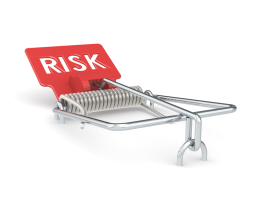In equipment leasing, there’s generally an inverse relationship between risk and cost. A high-risk equipment lease generally has a lower lease rate. Many enterprises understandably seek the lower rate, but this strategy will only be effective if the risks are well-understood, so that they can be minimized in the lease agreement and properly managed during operations.
Yet many enterprises entering into lease agreements just choose the low rate and don’t adequately recognize the risks.
 Leases classified as operating leases under current U.S. accounting standards will almost always involve a considerable level of risk, but it takes knowledge of how risk is structured into these leases to grasp how high that level of risk actually is. And it’s a mistake to assume that just because a lease agreement doesn’t qualify as an operating lease, it is low risk. It’s not hard for lessors to “fail” to meet the requirements for off-balance sheet treatment but still include substantial risk in the equipment lease.
Leases classified as operating leases under current U.S. accounting standards will almost always involve a considerable level of risk, but it takes knowledge of how risk is structured into these leases to grasp how high that level of risk actually is. And it’s a mistake to assume that just because a lease agreement doesn’t qualify as an operating lease, it is low risk. It’s not hard for lessors to “fail” to meet the requirements for off-balance sheet treatment but still include substantial risk in the equipment lease.
Making matters more difficult for lessees that don’t have access to equipment leasing expertise, the risk is often included in the lease schedules, not the master lease. Negotiating a seemingly risk-free master lease is not enough—each schedule must be evaluated for risk.
When looking for this risk, there are many potential culprits, but these five are some of the most common:
1. Interim Rent
Before a lease even officially begins, lessees can suffer budget-busting costs related to interim rent, which is charged (usually at full rate, pro-rated by number of days) for the period between delivery and acceptance and the lease’s commencement date. This cost should be well understood, defined, and capped in the equipment lease agreement.
2. Notice Requirements
Many leases contain notice requirements that are overly stringent and virtually impossible to meet operationally. Notice can be required for a lessee’s intent to return or purchase equipment, but also for common day-to-day actions, such as moving or repairing equipment.
These notices can be required in such a specific manner (e.g. by certified mail to a specially designated addressee), and in such a tight time frame that they can easily lead to non-compliance resulting in penalties, undesired lease extensions, and even default.
3. Default Provisions
If a lessee goes into default, it gives up leverage in negotiations over the future of the assets in the equipment lease agreement. Nonetheless, it’s not unusual for unwary lessees to agree to an equipment lease that makes the probability of going into default much higher than it should be.
4. Return Requirements
Lessors usually prefer that lessees continue leasing equipment rather than return it. For example lease agreements which stipulate that compliant return means the return of “all but not less than all” of the equipment on a lease schedule can result in full rent extension charges for every item on the schedule until the last piece of equipment is returned. As with default, almost-impossible-to-meet return conditions can easily result in the lessor having leverage at the end of the lease.
5. Fair Market Value
 A typical equipment lease will allow the lessee the option to purchase the equipment at “fair market value” (FMV) at the end of the lease. But because it is usually more profitable for lessors if the lease continues, lessors often propose lease terms that effectively allow them to set a FMV that’s higher than the true market value, putting lessees that can’t feasibly return the equipment in a position where extending the lease is the least-costly option, despite its undesirability.
A typical equipment lease will allow the lessee the option to purchase the equipment at “fair market value” (FMV) at the end of the lease. But because it is usually more profitable for lessors if the lease continues, lessors often propose lease terms that effectively allow them to set a FMV that’s higher than the true market value, putting lessees that can’t feasibly return the equipment in a position where extending the lease is the least-costly option, despite its undesirability.
Even if the FMV must be agreed upon by both parties, the lessor has the leverage because the lease payments will continue during the FMV negotiations.
Effective FMV language which include "in use and in place" should be avoided for example while terms such as "between a willing buyer and seller under no compulsion to buy or sell" are preferable.



